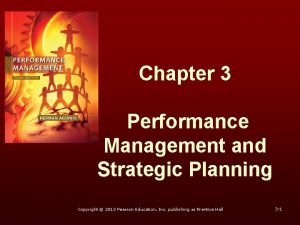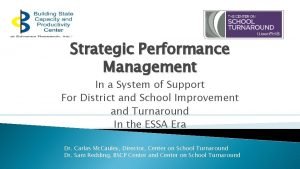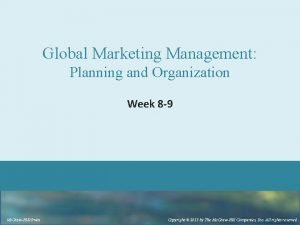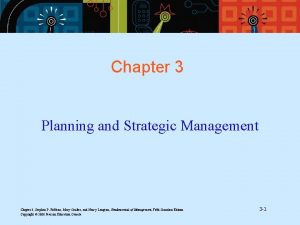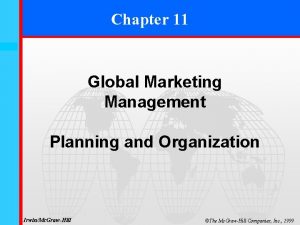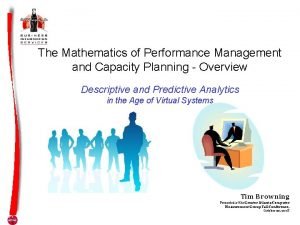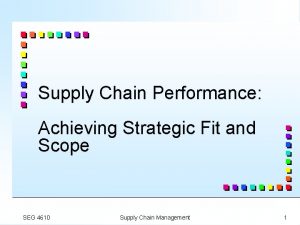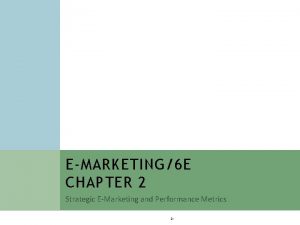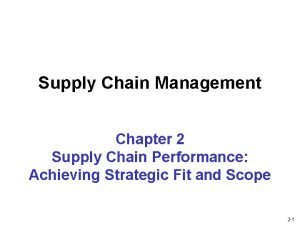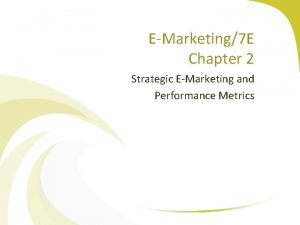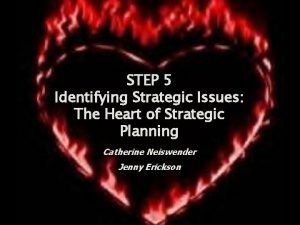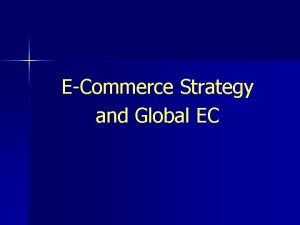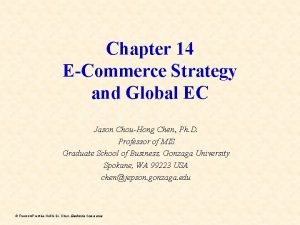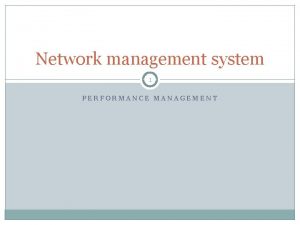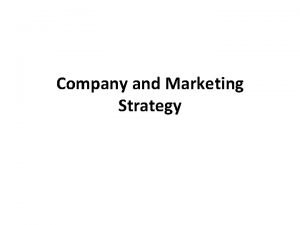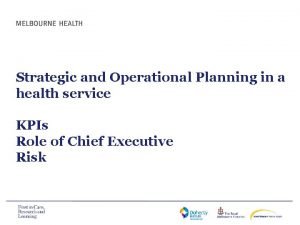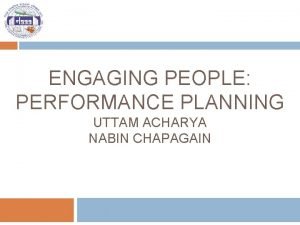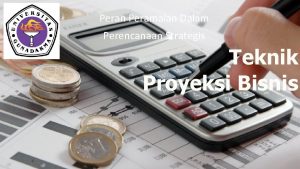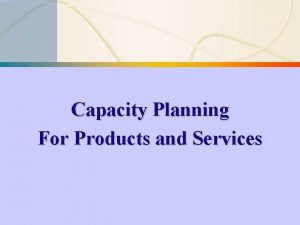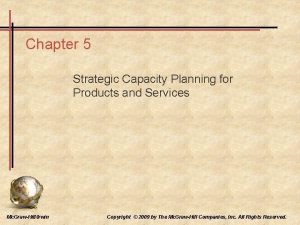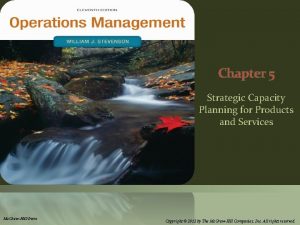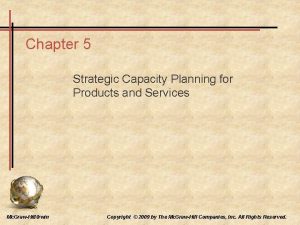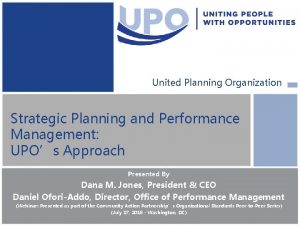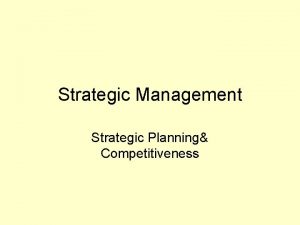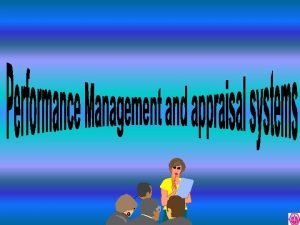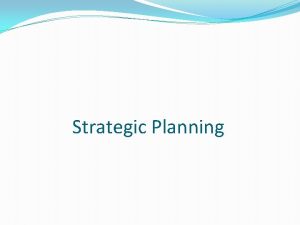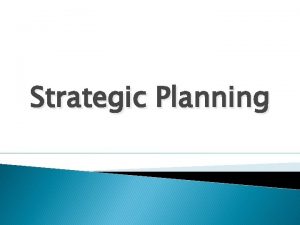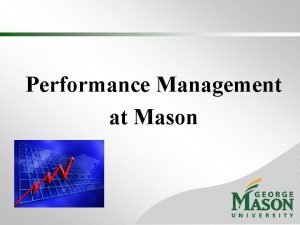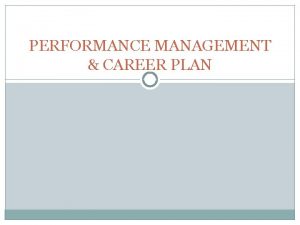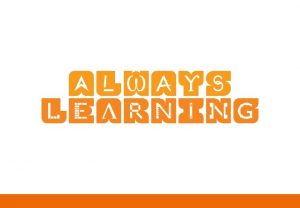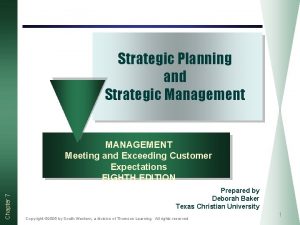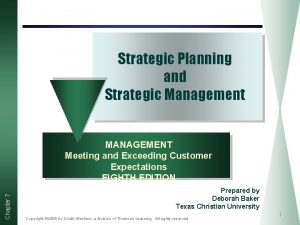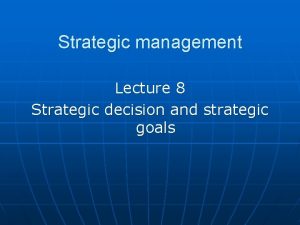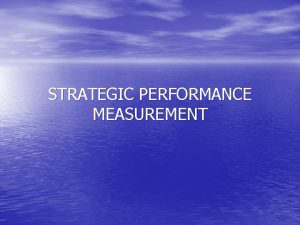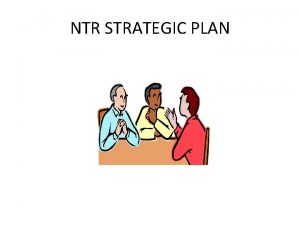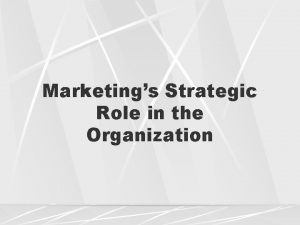United Planning Organization Strategic Planning and Performance Management

































- Slides: 33

United Planning Organization Strategic Planning and Performance Management: UPO’s Approach Presented By Dana M. Jones, President & CEO Daniel Ofori-Addo, Director, Office of Performance Management (Webinar: Presented as part of the Community Action Partnership’s Organizational Standards Peer-to-Peer Series) (July 17, 2018 - Washington, DC)

Overview • • About the United Planning Organization (UPO) Strategic Planning: From Process to Goals Development of Tactical Plans Shifting Focus to Performance Measurement and Management • Operationalizing Continuous Improvement – Quarterly Reviews / Accountability Process • Peer to Peer • Management to Board • Implementing Changes: Management and Staff • Evolution of a Complex Agency-Wide Scorecard – – Operational Effectiveness Strategic Plan Implementation Success Continuous Improvement Organizational Capacity Development • Exploring the Next Level of Performance Management

About UPO • Located in Washington, DC. • Mission: Uniting People with Opportunities – Uniting Clients with the Opportunity to Become Self-Sufficient. – Uniting Staff and Volunteers with the Opportunity to Fully Utilize Their Skills in Making a Difference. – Uniting Funders with the Opportunity to Invest in Transforming the Lives of Clients. – Uniting Partners with the Opportunity to Extend the Efficiency and Effectiveness of Services Delivered. – Uniting Residents with the Opportunity to help their Fellow Residents in Need. [Maximum Feasible Participation] • • Private nonprofit human service corporation. Established on December 10, 1962. Become a community action agency DC in 1964. The only designated CAA in the District of Columbia.

The inspiration that keeps us moving forward. 3

STRATEGIC PLANNING: FROM PROCESS TO GOALS

Getting Started • Top - Down Leadership • Kick Off by Board of Directors • Kick Off by Executive Director • Kick Off by Two Self-Study Work Groups – BOSS & POP • Powerful Questions • SWOT Analysis Commissioned • Bottom - Up • Review of Needs Assessment • Cross functional teams working together: – POP: The Product Opportunity and Performance Working Group – BOSS: The Business Opportunities Support Systems Working Group

POP Work Group • Research Questions Included: – To reduce poverty and move customers from dependency to self-sufficiency, what are the service areas that increase the likelihood of customer self-sufficiency. – What are the trends in service delivery? – Given our agency’s size and level of resources, what agency goals should we aim to achieve from FY 2013 -FY 2018? – What performance management systems should be implemented to assure greater accountability? – What have our clients expressed as their most urgent unfulfilled needs?

POP Work Group – Are we providing the right configuration of services to successfully meet those needs? – What should the organizational structure look like for UPO to be more agile and better able to respond to internal and external threats? – What would a de-centralized UPO look like and would that be more effective in moving the agency forward? – Who is our competition (including other community action agencies) and what are they doing differently to brand market their services? – Who should our target customers be and how are they identified? – What should our strategy be to attract customers in need? – What “Best Practices” have other private and public organizations implemented to attract their target customers?

POP Work Group – What program elements constitute a center of excellence and which agencies are modeling centers of excellence? – How can UPO deliver superior customer service that exceeds expectations? – What are the housing conditions in the District and what are our viable options for developing housing alternatives? – What community economic development activities should UPO undertake given the recent recession and on-going gentrification? – Who should be our strategic partners, (public, private, in/out-of-state) and how should we partner with them to better serve DC residents?

BOSS Work Group • Research Questions Included: – – – – What systems or policies hinder high performance at UPO? What areas lack clarity of direction and process? What areas consume too much time and money? What software upgrades, additions or changes are needed to enhance organizational performance? What other technology is needed to enhance efficiency and productivity? What will give us a competitive edge? What policies require updating to assure realistic and relevant management practices? What SOPs are missing but needed for effective and efficient service delivery?

BOSS Work Group – What changes are needed at UPO’s service locations to assure quality service delivery? – What equipment and software needs should be planned for between 2012 and 2017? – How will shifts in demographics and economic development impact UPO? – What is the “low hanging fruit” that can be secured with minimum capital investment that will give us an edge? – What are the strategic locations in the city for service delivery?

Research, Analysis and Synthesis of Findings • Multiple Surveys • Multiple Input Sessions: – – Customers Partners Volunteers Board of Directors • SWOT Analysis • Work Group Reviews and Deliberation • Separate Synthesis of Findings: – POP Group – BOSS Group • Subsequent Strategy Brainstorming Sessions.

Goal Development • Two Parallel Teams Commissioned to Analyze Content and Identify Goals. • Independent Content Analysis by Each Team: – Involved Detailed Reviews of the Findings of both Work Groups, their Suggestions and Proposed Strategies. – Each Team Identified Six Goals. – Five of the Six Goals Were Common to Both Lists. – The sixth was developed by fusing the remaining two. • Review and Adoption of Goals by Executive Team and by Board of Directors. • Commissioning of the Development of Tactical Plans by the Board of Directors. • Assignment of the Development of Tactical Plans by the Executive Team to all offices and divisions.

STRATEGIC GOALS 2013 - 2018 GOAL # 1. Continue to develop and implement a marketing and branding campaign a. Updated Material and Web Presence b. Social Marketing Approaches c. Host Voices Forums d. Friend Raising Sessions GOAL # 2. Increase Non Government resources by $5, 000 by September 30, 2018 a. Foundation Appeal b. Fee Based Services c. d. Private Sector Contracting Related Business Income Approaches GOAL # 3. Restructure Service Delivery System to focus on Economic Security with programming directed at family development through asset enhancement opportunities Strategy A. Employment Programming Strategy B. Expanded Adult Education and Training Division Strategy C. Early Learning Network Strategy D. Youth Division Continuum – ages 6 to 24 Strategy E. Create a Community Re-Investment Division Strategy F. Expanded Green Technology Division Strategy G. Community Health and Wellness Division GOAL # 4. Create and Grow Social Enterprise Opportunities a. Green Capital b. Facilities Management c. Child Care d. Substance Abuse Treatment e. Transportation GOAL # 5. Expand to become a Washington Metropolitan Regional Provider GOAL # 6. Modify business policies and practices to increase efficiencies and productivity 14

DEVELOPMENT OF TACTICAL PLANS

Division of Labor • Programmatic • Administrative Offices Development. Divisions of Tactical Plans • Task – Review • Division Mission • Division Goal • Division Objectives – Develop Tactical Steps to be undertaken to achieve applicable agency-level strategic goal – Identify • Staff person(s) responsible for each tactical activity • Timeframe • Outcome Indicators /Measurement Tool • Task – Review • Office Mission • Office Goal • Office Objectives – Develop Tactical Steps to be undertaken to achieve applicable agency-level strategic goal – Identify • Staff person(s) responsible for each tactical activity • Timeframe • Outcome Indicators /Measurement Tool

Leadership • Input Solicitation by the Leaders of Programmatic Divisions and Administrative Offices from Staff and Customers • One-on-One Reviews with Executive Team – By Division and Office Directors – Of Draft Tactical Plans Developed – Feedback and Improvement Suggestions • Recommendations for Improvements by Executive Team – – Taking the Long-term perspective Thinking outside the box encouraged Planning for Resource development and assessment Ensuring Tactical Plans Span all 5 Years of Strategic Plan Period • Presentation of Refined Tactical Plans to the Board – By Division Director and Executive Team – Board Input for revisions provided and incorporated. • Adoption of Tactical Plans

SHIFTING FOCUS TO PERFORMANCE: MEASUREMENT AND MANAGEMENT

Leadership • Application for COMPASS DC Grant/Project – By UPO’s Executive Team • Winning of COMPASS DC Consulting Project • UPO’s Assigned COMPASS DC Consulting Team Comprised 7 Members with MBAs from the top 20 Business Schools in the Country • Consulting Project Involved: – Analysis of Strategic Goals Developed – Analysis of Tactical Plans Developed – Development of Analytical Framework for Aggregating Performance on Tactical Steps – Delivery of Strategic Planning Performance Measurement Tool to UPO

Operationalizing Performance Management • Modification of Existing Performance Measurement Reporting • Reports Originally Called Chief Operating Office (COO) Reports – Enhancements Included: • • Tracking Human Resource Allocation, Availability and Use Tracking Budget to Actual Spending Relative to Program Performance Tracking Resource Leveraging Tracking of Performance on Tactical Plans • Reports Renamed: Performance Measurement Reports • Fomenting of a Discussion About A Robust Agency-Wide Scorecard – Need to Aggregate Programmatic, Administrative and Operational Performance – Need to Aggregate Performance on Tactical Plans and Strategic Plan – Results of Pathways Self-Study Pointed to the Need for a Scorecard. • Creation of an Office of Performance Management by UPO’s Executive Team by re-organizing existing reporting, evaluation and monitoring functions.

OPERATIONALIZING CONTINUOUS IMPROVEMENT

Leadership • Quarterly Presentations of Performance Measurement Reports (PMRs) – Monthly Managers’ Meeting Focused Wholly on PMRs Once Each Quarter • Outcomes Outside of Performance Targets Required Explanation • Peer-to-Peer Input provided by fellow Managers • Executive Team Input Provided – Quarterly Presentations by Program Managers to Program Operations Committee • Board Member Input on Programs Provided • Influence on Board Actions • Program Operations Committee of BOD Presents Major Themes and Findings to Full Board • Subsequent Board Agendas Shaped by PMR Content

Continuous Improvement • Redeployment of an already functioning Program Outcome Earnings System – For the Development of Program Plans and the Tracking of Outcomes. – Key program outcomes priced in such a way that full performance would earn full program budget. • Formalization of Quarterly Monitoring Reviews of All UPO Programs – Quarterly On-Site of Desk Audit Monitoring • • By Monitoring and Evaluation Analysts Sampling of data entered by front-line staff Reviews of actual performance relative to planned performance Review of operations relative to funder agreements, laws and regulations • Findings Documented in Formal Reports Shared with Program Staff and Executive Team • Critical Findings Trigger a requirement for a corrective action plan from the program reviewed • Corrective Action Plan Implementation Monitored by Monitoring and Evaluation Analysts

Continuous Improvement • Formalization of Monthly Issue Log Review – For the purpose of tracking unresolved findings – Monthly meetings focused on review of issue log • By Executive Team and Office of Performance Management – Unresolved findings become the focus of actions and interventions by Executive team – Programmatic team meetings involve discussions of team member roles in implementing corrective actions. • Semi-Annual Monitoring of Administrative Offices – Office Systems and Performance Relative to Best Practices – Surveys of Internal Customers and Level of Satisfaction with Services Delivered • Annual Customer Surveying and Analysis • Quarterly Customer Input Box Content Analysis • Quarterly Staff Input Box Content Analysis

Continuous Improvement • Monthly Monitoring Reviews of Funded Partner Program Performance by UPO’s Office of Performance Management – Program Outcome Earnings Reporting by Partners – Validation of Outcomes Reported – Payment Processing Contingent on Performance Level • Development of Standard Operating Procedures for Service Delivery • Development of Tools for Quality Assurance

Continuous Improvement • Expanding Staff Capacity to Achieve Results Through Targeted Training. – Periodic Special Emphasis Training for Staff Offered by Personnel of the Office of Performance Management • • • Intake Economic Security Assessment Basic Data Entry Case Management Training Review and Analysis of Programmatic Reports – ROMA Training • Offered at All New Hire Orientation Sessions • Full Day ROMA Training Facilitated Quarterly – Up to 25 Staff Trained Quarterly – Staff encouraged to receive full-day training at least once every three years – Strengths-Based Family Worker Training Offered Semi-Annually. – Strengths-Based Leadership Training Offered Annually. – Semi-Annual Special Emphasis Training Offered by Bowie State University to Selected Cohorts of UPO’s Staff and Management.

EVOLUTION OF A COMPLEX AGENCY-WIDE SCORECARD

Dimensions and Weighting Dimension Weight Organizational Standards 5% Agency Strategic Plan Progress 5% Financial Strength 5% Customer / Staff Input 5% Capacity Building / Maintenance 5% Program and Administrative Monitoring 5% ROMA / Programmatic Outcomes / Customer Self-Sufficiency 70%

Dimensions of Agency-Wide Scorecard 1. Organizational Standards – Percentage Organizational Standards Met or Not Met 2. Agency Strategic Plan Progress – Percentage of Tactical Steps Completed 3. Financial Strength – Percentage of Financial Oversight Review by Board of Directors and Managers Completed – Completion of Audit – Filing of 990 4. Customer / Staff Input – Percentage of Scheduled Surveys Completed and Analyzed • • • Customers Staff Funders Board Members Volunteers

Dimensions of Agency-Wide Scorecard 5. Capacity Building / Maintenance – Percentage of Scheduled Quarterly Full-Day ROMA Training Facilitated – Percentage of Scheduled Board Meetings and Board Committee Meetings Conducted – Percentage of Scheduled Performance Review Meetings Conducted at Management Level – Percentage of Scheduled Performance Review Meetings Conducted at Board Level – Percentage of Scheduled Central Client Data Tracking and Case Management Training Facilitated 6. Program and Administrative Monitoring – Percentage of Scheduled Quarterly Programmatic Monitoring Reviews Conducted – Percentage of Scheduled Semi-Annual Administrative Office Reviews Conducted 7. ROMA / Programmatic Outcomes / Customer Self-Sufficiency – Aggregated Performance Level of All Programmatic Divisions that Deliver Service Leading to Self-Sufficiency • Actual Performance as a Percentage of Projected Performance Levels • Emphasis is on the impact that services have on customer progress to self-sufficiency.

EXPLORING THE NEXT LEVEL OF PERFORMANCE MANAGEMENT AT UPO

Next Steps • Strategic Planning for FY 2019 to FY 2022 – Tactical Plan Development in Progress • Enhancing the Scorecard – Replacing Process Metrics with Result Metrics – Revisiting Role and Impact of Customer Satisfaction Survey Results on Agency-Wide Performance Score • Staff, Clients, Volunteers, Partners, BOD & Funders – Trending satisfaction levels based on results of surveys • Going beyond our Programmatic and Administrative Quarterly Performance Management Report presentations/reviews – Adding mid-year group examinations and discussions of agency-level performance in the collective deliberation sessions within the management team and with the BOD.

QUESTIONS ?
 Performance management and strategic planning
Performance management and strategic planning Industrial organization model of above average returns
Industrial organization model of above average returns Tows matrix
Tows matrix Strategic management performance system
Strategic management performance system Strategic planning for retail business
Strategic planning for retail business Role of strategic planning
Role of strategic planning Strategic planning vs tactical planning
Strategic planning vs tactical planning Global marketing management planning and organization
Global marketing management planning and organization Organization and management chapter 3 planning
Organization and management chapter 3 planning Global marketing management planning and organization
Global marketing management planning and organization Bars rating scale
Bars rating scale Behaviorally anchored rating scale
Behaviorally anchored rating scale Dirty data
Dirty data Puppy dog ploy
Puppy dog ploy Block essay
Block essay Implied uncertainty spectrum
Implied uncertainty spectrum Chapter 2
Chapter 2 Responsiveness spectrum
Responsiveness spectrum Strategic e-marketing and performance metrics
Strategic e-marketing and performance metrics Strategic fit vs strategic intent
Strategic fit vs strategic intent Identifying strategic issues facing the organization
Identifying strategic issues facing the organization Strategic organization means putting a speech together
Strategic organization means putting a speech together What is the strategic value of ec to the organization?
What is the strategic value of ec to the organization? What is the strategic value of ec to the organization?
What is the strategic value of ec to the organization? Process organization in computer organization
Process organization in computer organization Network performance management functions
Network performance management functions Company wide strategy
Company wide strategy Strategic and operational planning in healthcare
Strategic and operational planning in healthcare Strategic and operational planning
Strategic and operational planning Strategi peramalan
Strategi peramalan Products and services
Products and services Developing capacity strategies
Developing capacity strategies Strategic capacity planning for products and services
Strategic capacity planning for products and services Strategic capacity planning for products and services
Strategic capacity planning for products and services
